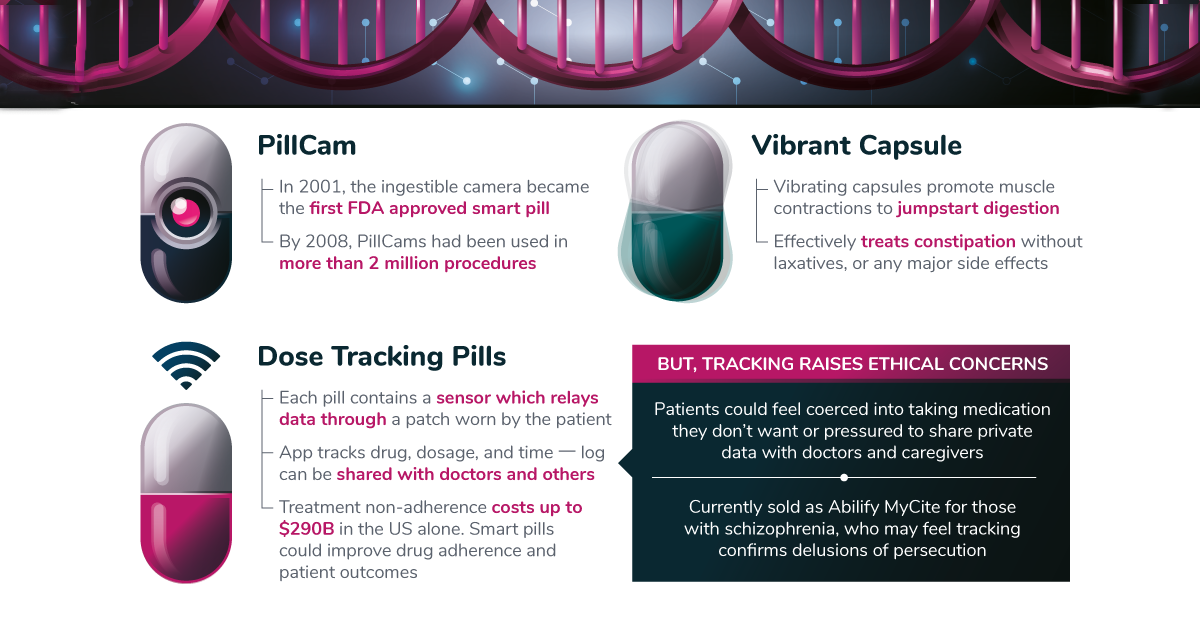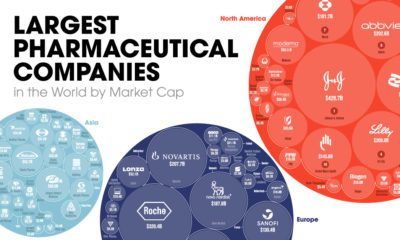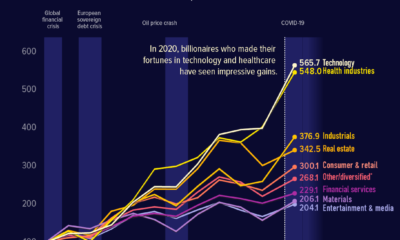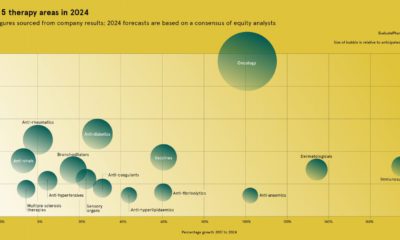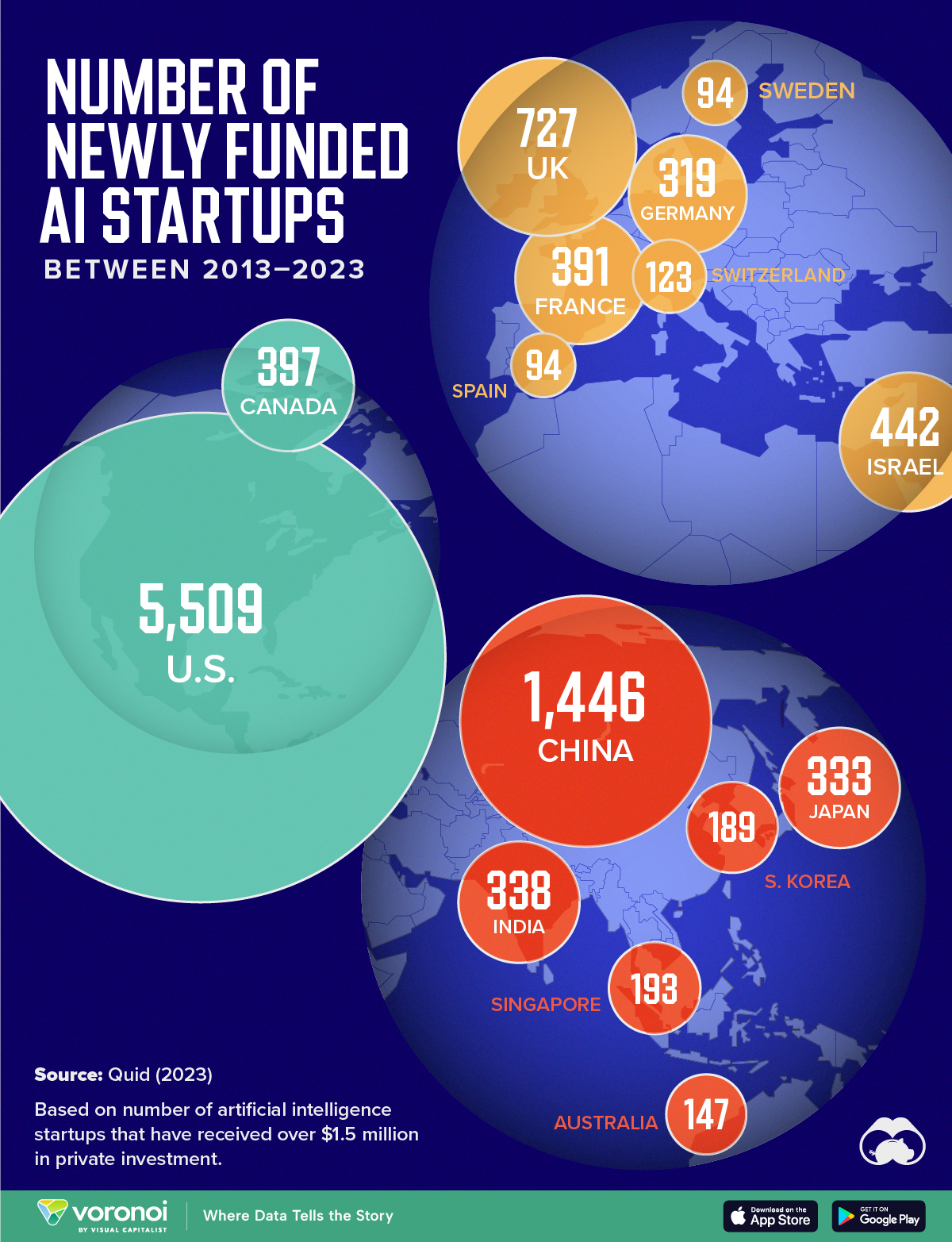Technology
The Future of Nanotechnology in Medicine

The Future of Nanotechnology in Medicine
Around the world, researchers are increasingly thinking smaller to solve some of the biggest problems in medicine.
Though most biological processes happen at the nano level, it wasn’t until recently that new technological advancements helped in opening up the possibility of nanomedicine to healthcare researchers and professionals.
Today’s infographic, which comes to us from Best Health Degrees, highlights some of the most promising research in nanomedicine.
What is Nanotechnology?
Nanotechnology is the engineering of functional systems at the molecular level. The field combines elements of physics and molecular chemistry with engineering to take advantage of unique properties that occur at nanoscale.
One practical example of this technology is the use of tiny carbon nanotubes to transport drugs to specific cells. Not only do these nanotubes have low toxicity and a stable structure, they’re an ideal container for transporting drugs directly to the desired cells.
Small Systems, Big Applications
While many people will be most familiar with nanotech as the technology powering Iron Man’s suit, real world breakthroughs at the nanoscale will soon be saving lives in healthcare.
Here are a few ways nanotechnology is shaping the future of medical treatment:
1. Smart Pills
While smart pill technology is not a new idea — a “pill cam” was cleared by the FDA in 2001 — researchers are coming up with innovative new applications for the concept.
For example, MIT researchers designed an ingestible sensor pill that can be wirelessly controlled. The pill would be a “closed-loop monitoring and treatment” solution, adjusting the dosage of a particular drug based on data gathered within the body (e.g. gastrointestinal system).
An example of this technology in action is the recent FDA-approved smart pill that records when medication was taken. The product, which is approved for people living with schizophrenia and bipolar disorder, allows patients to track their own medication history through a smartphone, or to authorize physicians and caregivers to access that information online.
2. Beating the Big C
Nearly 40% of humans will be diagnosed with cancer at some point in their lifetime, so any breakthrough in cancer treatment will have a widespread impact on society.
On the key issues with conventional chemotherapy and radiation treatments is that the body’s healthy cells can become collateral damage during the process. For this reason, researchers around the world are working on using nano particles to specifically target cancer cells.
Oncology-related drugs have the highest forecasted worldwide prescription drug sales, and targeting will be a key element in the effectiveness of these powerful new drugs.
3. Diagnostics
Medical implants — such as knee and hip replacements — have improved the lives of millions, but a common problem with these implants is the risk of post-surgery inflammation and infection. In many cases, symptoms from an infection are detected so late that treatment is less effective, or the implant will need to be replaced all together.
Nanoscale sensors embedded directly into the implant or surrounding area could detect infection much sooner. As targeted drug delivery becomes more feasible, it could be possible to administer treatment to an infected area at the first sign of infection.
Examples like this show the true promise of nanotechnology in the field of medicine. Before long, gathering data from within the body and administering treatments in real-time could move from science fiction to the real world.
10,000 years ago, man domesticated plants and animals, now it’s time to domesticate molecules.
– Professor Susan Lindquist
Digital Transformation
Mapped: The Number of AI Startups By Country
Over the past decade, thousands of AI startups have been funded worldwide. See which countries are leading the charge in this map graphic.
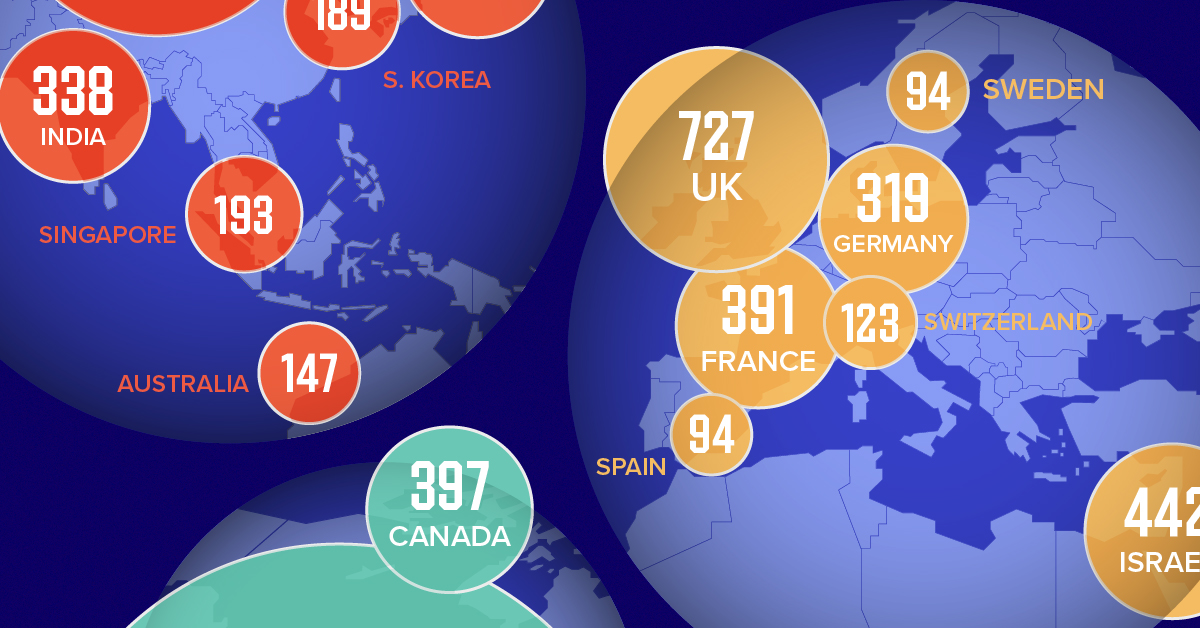
Mapped: The Number of AI Startups By Country
This was originally posted on our Voronoi app. Download the app for free on iOS or Android and discover incredible data-driven charts from a variety of trusted sources.
Amidst the recent expansion of artificial intelligence (AI), we’ve visualized data from Quid (accessed via Stanford’s 2024 AI Index Report) to highlight the top 15 countries which have seen the most AI startup activity over the past decade.
The figures in this graphic represent the number of newly funded AI startups within that country, in the time period of 2013 to 2023. Only companies that received over $1.5 million in private investment were considered.
Data and Highlights
The following table lists all of the numbers featured in the above graphic.
| Rank | Geographic area | Number of newly funded AI startups (2013-2023) |
|---|---|---|
| 1 | 🇺🇸 United States | 5,509 |
| 2 | 🇨🇳 China | 1,446 |
| 3 | 🇬🇧 United Kingdom | 727 |
| 4 | 🇮🇱 Israel | 442 |
| 5 | 🇨🇦 Canada | 397 |
| 6 | 🇫🇷 France | 391 |
| 7 | 🇮🇳 India | 338 |
| 8 | 🇯🇵 Japan | 333 |
| 9 | 🇩🇪 Germany | 319 |
| 10 | 🇸🇬 Singapore | 193 |
| 11 | 🇰🇷 South Korea | 189 |
| 12 | 🇦🇺 Australia | 147 |
| 13 | 🇨🇭 Switzerland | 123 |
| 14 | 🇸🇪 Sweden | 94 |
| 15 | 🇪🇸 Spain | 94 |
From this data, we can see that the U.S., China, and UK have established themselves as major hotbeds for AI innovation.
In terms of funding, the U.S. is massively ahead, with private AI investment totaling $335 billion between 2013 to 2023. AI startups in China raised $104 billion over the same timeframe, while those in the UK raised $22 billion.
Further analysis reveals that the U.S. is widening this gap even more. In 2023, for example, private investment in the U.S. grew by 22% from 2022 levels. Meanwhile, investment fell in China (-44%) and the UK (-14.1%) over the same time span.
Where is All This Money Flowing To?
Quid also breaks down total private AI investment by focus area, providing insight into which sectors are receiving the most funding.
| Focus Area | Global Investment in 2023 (USD billions) |
|---|---|
| 🤖 AI infrastructure, research, and governance | $18.3 |
| 🗣️ Natural language processing | $8.1 |
| 📊 Data management | $5.5 |
| ⚕️ Healthcare | $4.2 |
| 🚗 Autonomous vehicles | $2.7 |
| 💰 Fintech | $2.1 |
| ⚛️ Quantum computing | $2.0 |
| 🔌 Semiconductor | $1.7 |
| ⚡ Energy, oil, and gas | $1.5 |
| 🎨 Creative content | $1.3 |
| 📚 Education | $1.2 |
| 📈 Marketing | $1.1 |
| 🛸 Drones | $1.0 |
| 🔒 Cybersecurity | $0.9 |
| 🏭 Manufacturing | $0.9 |
| 🛒 Retail | $0.7 |
| 🕶️ AR/VR | $0.7 |
| 🛡️ Insurtech | $0.6 |
| 🎬 Entertainment | $0.5 |
| 💼 VC | $0.5 |
| 🌾 Agritech | $0.5 |
| ⚖️ Legal tech | $0.4 |
| 👤 Facial recognition | $0.3 |
| 🌐 Geospatial | $0.2 |
| 💪 Fitness and wellness | $0.2 |
Attracting the most money is AI infrastructure, research, and governance, which refers to startups that are building AI applications (like OpenAI’s ChatGPT).
The second biggest focus area is natural language processing (NLP), which is a type of AI that enables computers to understand and interpret human language. This technology has numerous use cases for businesses, particularly in financial services, where NLP can power customer support chatbots and automated wealth advisors.
With $8 billion invested into NLP-focused startups during 2023, investors appear keenly aware of this technology’s transformative potential.
Learn More About AI From Visual Capitalist
If you enjoyed this graphic, be sure to check out Visualizing AI Patents by Country.
-

 Economy7 days ago
Economy7 days agoRanked: The Top 20 Countries in Debt to China
-

 Demographics2 weeks ago
Demographics2 weeks agoThe Countries That Have Become Sadder Since 2010
-

 Money2 weeks ago
Money2 weeks agoCharted: Who Has Savings in This Economy?
-

 AI2 weeks ago
AI2 weeks agoVisualizing AI Patents by Country
-

 Economy2 weeks ago
Economy2 weeks agoEconomic Growth Forecasts for G7 and BRICS Countries in 2024
-

 Wealth2 weeks ago
Wealth2 weeks agoCharted: Which City Has the Most Billionaires in 2024?
-

 Technology1 week ago
Technology1 week agoAll of the Grants Given by the U.S. CHIPS Act
-

 Green1 week ago
Green1 week agoThe Carbon Footprint of Major Travel Methods

